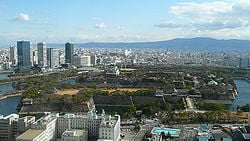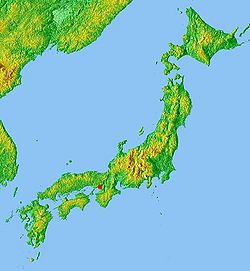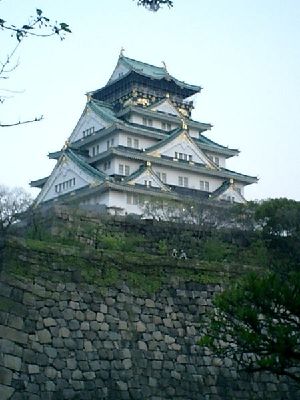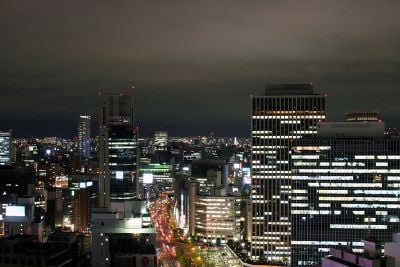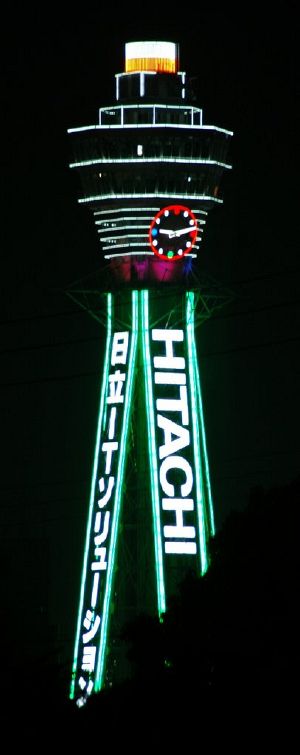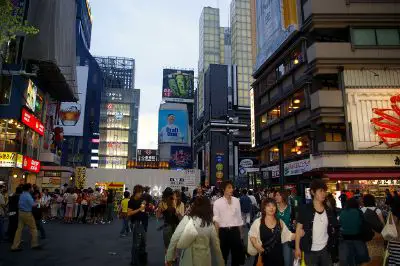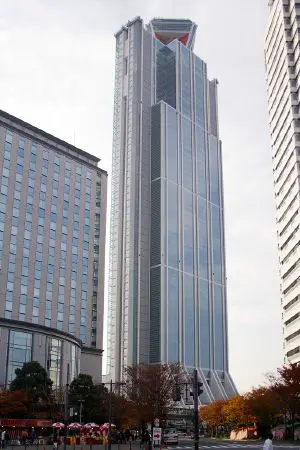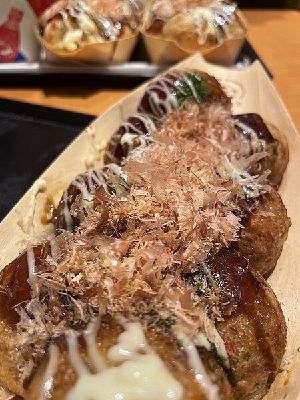Osaka
| Osaka 大阪 |
|||
| — Designated city — | |||
| 大阪市 · Osaka City | |||
| Osaka Castle Park | |||
|
|||
| Location of Osaka in Osaka Prefecture | |||
| Coordinates: 34°42′N 135°30′E | |||
|---|---|---|---|
| Country | Japan | ||
| Region | Kansai | ||
| Prefecture | Osaka | ||
| Government | |||
| - Mayor | Hideyuki Yokoyama | ||
| Area | |||
| - Designated city | 223.00 km² (86.1 sq mi) | ||
| Population (March 1, 2021) | |||
| - Designated city | 2,753,862 | ||
| - Density | 12,214/km² (31,634.1/sq mi) | ||
| - Metro | 19,303,000 | ||
| City | Symbols | ||
| Tree | Sakura | ||
| Flower | Pansy | ||
| Website: Osaka Official Website | |||
Osaka (大阪市 Ōsaka-shi) is a city in Japan, located at the mouth of the Yodo River on Osaka Bay, in the Kansai region of the main island of Honshū. The city is the capital of Osaka Prefecture. Often dubbed the second city of Japan, Osaka was historically the commercial capital of Japan, and is the heart of Japan's second largest, and the world's ninth largest metropolitan area. While at night time the population ranks third place in the country, in daytime it surges to be second only to Tokyo. The population of Osaka is considerably lower than its peak in the 1960s, and since the end of the 1990s, many major companies have moved their main offices to Tokyo. Recently the city has begun a program, to try to attract domestic and foreign in investment to the city.
Osaka is home to the innovative Kansai Airport, built on an artificial island in Osaka Bay and designed to withstand typhoons and earthquakes. Osaka is traditionally considered the "nation's kitchen" (天下の台所 tenka no daidokoro) or the gourmet food capital of Japan. The city has a long history and is home to many ancient shrines and temples, and to the famous Osaka Castle, built by Toyotomi Hideyoshi in the late sixteenth century.
History
The beginnings - Kofun period
Some of the earliest signs of habitation in the area of Osaka were found at the Morinomiya ruins (森の宮遺跡 ; Morinomiya iseki), with its shell mounds, including sea oyster shells and buried human skeletons from the fifth - sixth centuries B.C.E. It is believed that what is today the Uehonmachi area consisted of a peninsular land, with an inland sea in the east. During the Yayoi Period, permanent habitation on the plains grew as rice farming became popular.[1]
By the Kofun Period, Osaka had developed into a hub port, connecting the region to the western part of Japan. The large numbers, and the increasing size of, tomb mounds found in the plains of Osaka, are seen as evidence of a concentration of political power, leading to the formation of a state.[1]
Asuka and Nara period
In 645, Emperor Kōtoku built his palace (難波長柄豊碕宮 Naniwa-no-nagara-no-toyosaki-no-Miya) in Osaka, making this area the capital (Naniwa-kyō). The area which now comprises Osaka city was called Naniwa, a name which still exists as the names of districts in central Osaka as Naniwa (浪速) and Namba (難波). Though the capital was moved to Asuka (in Nara Prefecture today) in 655, Naniwa has always remained a vital connection, by land and sea, between Yamato (modern day Nara Prefecture), Korea, and China.[1][2]
In 744, Naniwa was once again briefly named capital by Emperor Shōmu, but the Imperial Court moved back to Heijō-kyō (now Nara) in 745. The city’s function as a sea port function was gradually taken over by neighboring lands by the end of Nara Period, but it remained a lively transit center for river, channel and land transportation between Heian-kyō (Kyoto today) and other destinations.
Heian - Edo period
In 1496, the Jōdo Shinshū Buddhist sect set up their headquarters, the heavily fortified Ishiyama Hongan-ji, on top of the ruins of the old Naniwa imperial palace. In 1570, Oda Nobunaga started a siege of the temple that lasted for ten years. The monks finally surrendered in 1580, the temple was razed, and Toyotomi Hideyoshi took the site for his own castle, Osaka Castle.
Osaka was for a long time Japan's most important economic center, with a large percentage of the population belonging to the merchant class. Over the course of the Edo period (1603–1867), Osaka grew into one of Japan's major cities and returned to its ancient role as a lively and important port. Developing in parallel with the urban culture of Kyoto and Edo, Osaka also featured bunraku and grand kabuki productions, pleasure quarters, and a lively artistic community.
Modern Osaka
The modern city was initially designated in 1889 by government ordinance, starting with an area of only 15 km², overlapping today's Chūō and Nishi wards. Later the city went through three major expansions to reach its current size of 222 km².
"Osaka" (大阪) Etymology
Osaka literally means "Large Hill." It is unclear when the name Ōsaka gained prominence over Naniwa, but the oldest usage of the name dates back to 1496, in a text written about the foundation of the Ishiyama Hongan-ji. At this time, the second kanji was "坂," instead of the "阪" used today. In the beginning of Meiji Era, the government changed the second kanji 坂 to 阪 because the previous one could, if the radicals were read separately, be interpreted as "(will) return to soil" (土に返る), which seemed inauspicious. This remains the official spelling today, though the old one is still in very limited use to emphasize history.
Geography
The city of Osaka has its west side open to Osaka Bay. It is otherwise completely surrounded by more than ten smaller cities, all of them in Osaka Prefecture, with one exception: the city of Amagasaki, belonging to Hyōgo Prefecture, in the north-west. The city occupies a larger area (about 12 percent) than any other city or district within Osaka Prefecture.
The two most crowded centers of the city of Osaka are often called by their synonyms: Kita (キタ, lit. north) and Minami (ミナミ, lit. south). Kita is roughly the area including or surrounding the business and retail district of Umeda. Minami is home to the Namba, Shinsaibashi and Dōtonbori shopping districts. The entertainment area around Dōtonbori Bridge, with its famous giant mechanical crab, Triangle Park and Amerikamura ("America Village") are in Minami. The traditional business district, including the courts and regional headquarters of major banks, is primarily located in Yodoyabashi and Honmachi, between Kita and Minami. The newer business district is the OBP, Osaka Business Park, located in the neighborhood of Osaka Castle. Business districts have also formed around the city's secondary rail termini, such as Tennoji Station and Kyobashi Station.
The proverbial adage, “The 808 bridges of Naniwa,” was a famous expression for awe and wonder in old Japan. “Naniwa” was the ancient name of Osaka and “808” was a large number that in Japan symbolizes the concept “uncountable.”[1]
Shopping Districts
- American Village (Ame-mura)
- Den Den Town electrical goods shopping district
- Dōtonbori
- Namba
- Shinsaibashi
- Umeda (theaters, boutiques and department stores)
Wards
Osaka has 24 wards (ku), one more than Tokyo:
|
|
Demographics
Osaka is the heart of Japan's second largest metropolitan area of Osaka-Kobe-Kyoto.
Osaka holds first place in Japan for its day to night population ratio of 141%, [3] a clear statement of Osaka's commercial character. While at night time the population ranks third place in the country, in daytime it surges to be second only after Tokyo.
The commonly spoken dialect of this area is Osaka-ben. An example, among many other particularities that characterizes Osaka-ben, is the use of the suffix hen instead of nai in the negative of verbs.
Economy
Historically, Osaka was the center of Japanese commerce, especially in the middle and premodern ages. Today, many major companies have moved their main offices to Tokyo, especially since the end of 1990s, but several major companies are still based in Osaka.
Commerce, services, and manufacturing are the three major industries.
Transport
Air
Kansai International Airport is the main airport: it is a rectangular artificial island that sits off-shore in Osaka Bay and services Osaka and its surrounding cities of Nara, Kobe, and Kyoto. Three mountains were excavated to create the island on which the airport is situated. The project became the most expensive civil works project in modern history, after twenty years of planning, three years of construction and twenty billion dollars of investment. However, much of what was learned went into the successful artificial islands in silt deposits for New Kitakyushu Airport, Kobe Airport, and Chubu International Airport. The airport opened in 1994. On January 17, 1995, the airport survived unscathed through the Kobe earthquake, whose epicenter was only 20 km away, mostly due to the use of sliding joints in its construction. In 1998, the airport survived a typhoon with wind speeds of up to 200 km/h. On April 19, 2001, the airport was one of ten structures given the "Civil Engineering Monument of the Millennium" award by the American Society of Civil Engineers as one of the ten civil engineering achievements with the greatest positive impact on life in the twentieth century.[4]
Kansai is the geographical term for the area of western Honshū surrounding Osaka. The airport is linked by a bus and train service into the center of the city and major suburbs. Osaka International Airport, laid over the border between the cities of Itami and Toyonaka, still houses most of the domestic service from the metropolitan region.
Rail
The Osaka Municipal Subway system is Osaka's extensive rapid transit system. The system ranks 8th in the world in annual passenger ridership, serving over 912 million people annually. Besides this, there is a network of both JR and private lines connecting the suburbs of the city, and Osaka to its neighbors. Keihan and Hankyu lines connect to Kyoto, Hanshin and Hankyu lines connect to Kobe, the Kintetsu line connects to Nara and Nagoya, and the Nankai line to Wakayama.
Culture
Museums and Galleries
Municipal Museums
- Museum of Oriental Ceramics, Osaka Founded in 1982. It houses 2000 pieces of ceramics. It also features a natural-light gallery for its Korean celadon pottery.
- Osaka City Museum of Modern Art
- Osaka Municipal Museum of Art
- Osaka Museum of History
- Osaka Museum of Natural History
- Osaka Science Museum
Other Museums
- Kamigata Ukiyoe Museum
- Osaka International Peace Center (Peace Osaka)
Theatres and Multi-purpose Halls
- Festival Hall
- Namba Grand Kagetsu
- National Bunraku Theater
- Osaka Central Public Hall
- Osaka-jō Hall
- Osaka Shin-Kabuki-za
- The Osaka Shiki Theater - Shiki Theatre Company.
- The Symphony Hall
- Umeda Arts Theater, the former Umeda Koma Theater
Cuisine
Osaka is traditionally considered the "nation's kitchen" (天下の台所 tenka no daidokoro) or the gourmet food capital of Japan.[5][6][7] Osaka’s reputation as a culinary mecca is supported by the saying "Dress (in kimonos) 'til you drop in Kyoto, eat 'til you drop in Osaka" (京の着倒れ、大阪の食い倒れ).
Osaka regional cuisine includes okonomiyaki (pan-fried batter cake), takoyaki (octopus dumplings), udon (a noodle dish), as well as regional sushi and other traditional Japanese foods.
Places of Interest
Osaka is known for bunraku (traditional puppet theater) and kabuki theater, and for manzai, a more contemporary form of stand-up comedy. Tourist attractions include:
Amusement Parks
- Expoland
- Festival Gate
- Osaka Aquarium Kaiyukan (海遊館)—an aquarium located in Osaka Bay, containing 35,000 aquatic animals in 14 tanks, the largest of which holds 5,400 tons of water and houses a variety of sea animals including whale sharks. This tank is the world's second largest aquarium tank, behind the Georgia Aquarium, whose largest tank holds approximately 29,000 tons of water.
- Tempozan Harbor Village Ferris wheel, located next to the aquarium
- Tennōji Zoo
- Universal Studios Japan
- Umeda Joypolis Sega
- Shin-Umeda City - an innovative structure with a floating garden observatory 170 m above the ground which offers a spectacular 360-degree panoramic view of Osaka. Thestructure also houses an underground mall with restaurants and a Zen garden; it is built in the early Showa style of the 1920s.
Parks
- Nakanoshima Park: In the vicinity of the City Hall.
- Osaka Castle Park: About 106 ha. Holds: Osaka-jō Hall, a Japanese apricot garden, and various amusements.
- Sumiyoshi Park
- Tennōji Park : About 28 ha. Holds: Tennōji Zoo, an art museum (established by contribution from Sumitomo family in 1936) and a japanese garden, Keitaku-en (慶沢園). Keitaku-en was constructed in 1908 by Jihei Ogawa (小川治兵衛), an illustrious gardener in Japan. This was one of the Sumitomo family's gardens until 1921.
- Nishinari Park
- Utsubo Park
- Nagai Park The IAAF World Championships in Athletics are currently being held at Nagai Stadium, located in this park.
- Tsurumi-Ryokuchi Park: held a flower expo in 1990.
Temples and Shrines
- Mitami Shrine
- Osaka Castle
- Sanko Shrine
- Shitennō-ji The oldest Buddhist temple in Japan, established in 593 C.E. by Prince Shōtoku.
- Sumiyoshi Taisha One of the oldest Shinto shrines; many people go and worship at this shrine on the new year day. It is said this shrine was built in 211 C.E.
- Tamatsukuri Inari Shrine
Sports Stadiums
- Osaka Dome
- Osaka Prefectural Gymnasium
- Nagai Stadium
Shopping
- Nippombashi Den Den Town
- Tenjinbashi-suji shopping arcade
- Shopping Districts
Osaka has a vast number of shopping areas to choose from, including malls and a large number of shopping arcades, or roofed shopping streets. Osaka has the longest shopping arcade in Japan. Tenjinbashi-suji stretches from the road approaching the Tenman-gu shrine and continues for 2.6 km, going north to south, and has all types of stores including commodities, clothing and catering outlets on both sides of the arcade. Other key shopping areas are Den Den Town, the electronic and manga/anime district resembles Tokyo’s Akihbara; and the Umeda district, which has the Hankyu Sanbangai shopping mall and Yodobashi Camera, a vast range of fashion stores, restaurants and a Shonen Jump store.
Education
Public elementary and junior high schools in Osaka are operated by the city of Osaka. Its supervisory organization on educational matters is Osaka City Board of Education [1]. Public high schools are operated by Osaka Prefectural Board of Education.
A large number of universities were once located in Osaka city center, but because of growing campuses and the need for larger area, many universities chose to move to the suburbs.
Osaka Prefecture's most prestigious university, Osaka University, is located in the nearby Suita.
- Kansai University (関西大学)
- Osaka City University (大阪市立大学)
- Osaka University of Economics (大阪経済大学)
- Osaka Institute of Technology (大阪工業大学)
- Osaka Jogakuin College (大阪女学院大学)
- Osaka Seikei University (大阪成蹊大学)
- SOAI University (相愛大学)
- Osaka University of Arts (大阪芸術大学) , Minamikawachi District, Osaka
- Osaka University of Education (大阪教育大学)
Libraries
- International Institute for Children's Llterature, Osaka
- Osaka Public Nakanoshima Library
Notes
- ↑ 1.0 1.1 1.2 1.3 Historical overview Osaka City 大阪市The City of Osaka official website. Retrieved July 17, 2023.
- ↑ Peter G. Stone and Philippe G. Planel (eds.), The constructed past: experimental archaeology, education, and the public (London, UK: Routledge in association with English Heritage, 1999, ISBN 0415117682).
- ↑ Population Census: I Daytime Population Statistics Bureau, Ministry of Internal Affairs and Communications. Retrieved July 17, 2023.
- ↑ Monument of the Millennium Kansai Airports. Retrieved July20, 2023.
- ↑ Aprodicio A. Laquian, Beyond metropolis: the planning and governance of Asia's mega-urban regions (Washington, DC: Woodrow Wilson Center Press, 2005, ISBN 0801881765).
- ↑ James L. McClain (ed.), Osaka, the merchants' capital of early modern Japan (Ithaca, NY: Cornell University Press, 1999, ISBN 9780801436307).
- ↑ Robert C. Hsu, The MIT encyclopedia of the Japanese economy (Cambridge, MA: MIT Press, 1999, ISBN 0262082802).
ReferencesISBN links support NWE through referral fees
- Gerstle, C. Andrew, Timothy Clark, and Akiko Yano. Kabuki heroes on the Osaka stage, 1780-1830. Honolulu: University of Hawai'i Press, 2005. ISBN 9780824823924
- Hanes, Jeffrey E., and Hajime Seki. The city as subject Seki Hajime and the reinvention of modern Osaka. Twentieth-century Japan. Berkeley: University of California Press, 2002. ISBN 9780520228498
- Hsu, Robert C. The MIT encyclopedia of the Japanese economy. Cambridge, MA: MIT Press, 1999. ISBN 0262082802
- Laquian, Aprodicio A. Beyond metropolis: the planning and governance of Asia's mega-urban regions. Washington, DC: Woodrow Wilson Center Press, 2005. ISBN 0801881765
- McClain, James L. (ed.). Osaka, the merchant's capital of early modern Japan. Ithaca, NY: Cornell University Press, 1999. ISBN 9780801436307
- Najita, Tetsuo. Visions of virtue in Tokugawa Japan the Kaitokudō Merchant Academy of Osaka. Honolulu: University of Hawai'i Press, 1997. ISBN 0585328366
- Schwaab, Dean J. Osaka prints. New York: Rizzoli, 1989. ISBN 0847810747
- Stone, Peter G. and Philippe G. Planel (eds.). The constructed past: experimental archaeology, education, and the public. London, UK: Routledge in association with English Heritage, 1999. ISBN 0415117682.
External links
All links retrieved July 17, 2023.
- A collection of articles about the Kamagasaki area of Osaka Libcom.
- Osaka Lonely Planet
- A History of Osaka, Japan’s City of Water Nippon.com
- 大阪市立東洋陶磁美術館 The Museum of Oriental Ceramics, Osaka
- Osaka Museum of Natural History
Regions
Hokkaidō ·
Tōhoku ·
Kantō ·
Chūbu
(Hokuriku • Kōshin'etsu • Tōkai • Chūkyō) ·
Kansai ·
Chūgoku ·
Shikoku ·
Kyūshū ·
Ryūkyū
Prefectures
Aichi ·
Akita ·
Aomori ·
Chiba ·
Ehime ·
Fukui ·
Fukuoka ·
Fukushima ·
Gifu ·
Gunma ·
Hiroshima ·
Hokkaidō ·
Hyōgo ·
Ibaraki ·
Ishikawa ·
Iwate ·
Kagawa ·
Kagoshima ·
Kanagawa ·
Kōchi ·
Kumamoto ·
Kyōto ·
Mie ·
Miyagi ·
Miyazaki ·
Nagano ·
Nagasaki ·
Nara ·
Niigata ·
Ōita ·
Okayama ·
Okinawa ·
Ōsaka ·
Saga ·
Saitama ·
Shiga ·
Shimane ·
Shizuoka ·
Tochigi ·
Tokushima ·
Tōkyō ·
Tottori ·
Toyama ·
Wakayama ·
Yamagata ·
Yamaguchi ·
Yamanashi
Designated cities
Special wards of Tokyo ·
Chiba ·
Fukuoka ·
Hamamatsu ·
Hiroshima ·
Kawasaki ·
Kitakyushu ·
Kobe ·
Kyoto ·
Nagoya ·
Niigata ·
Osaka ·
Saitama ·
Sakai ·
Sapporo ·
Sendai ·
Shizuoka ·
Yokohama
Credits
New World Encyclopedia writers and editors rewrote and completed the Wikipedia article in accordance with New World Encyclopedia standards. This article abides by terms of the Creative Commons CC-by-sa 3.0 License (CC-by-sa), which may be used and disseminated with proper attribution. Credit is due under the terms of this license that can reference both the New World Encyclopedia contributors and the selfless volunteer contributors of the Wikimedia Foundation. To cite this article click here for a list of acceptable citing formats.The history of earlier contributions by wikipedians is accessible to researchers here:
The history of this article since it was imported to New World Encyclopedia:
Note: Some restrictions may apply to use of individual images which are separately licensed.
